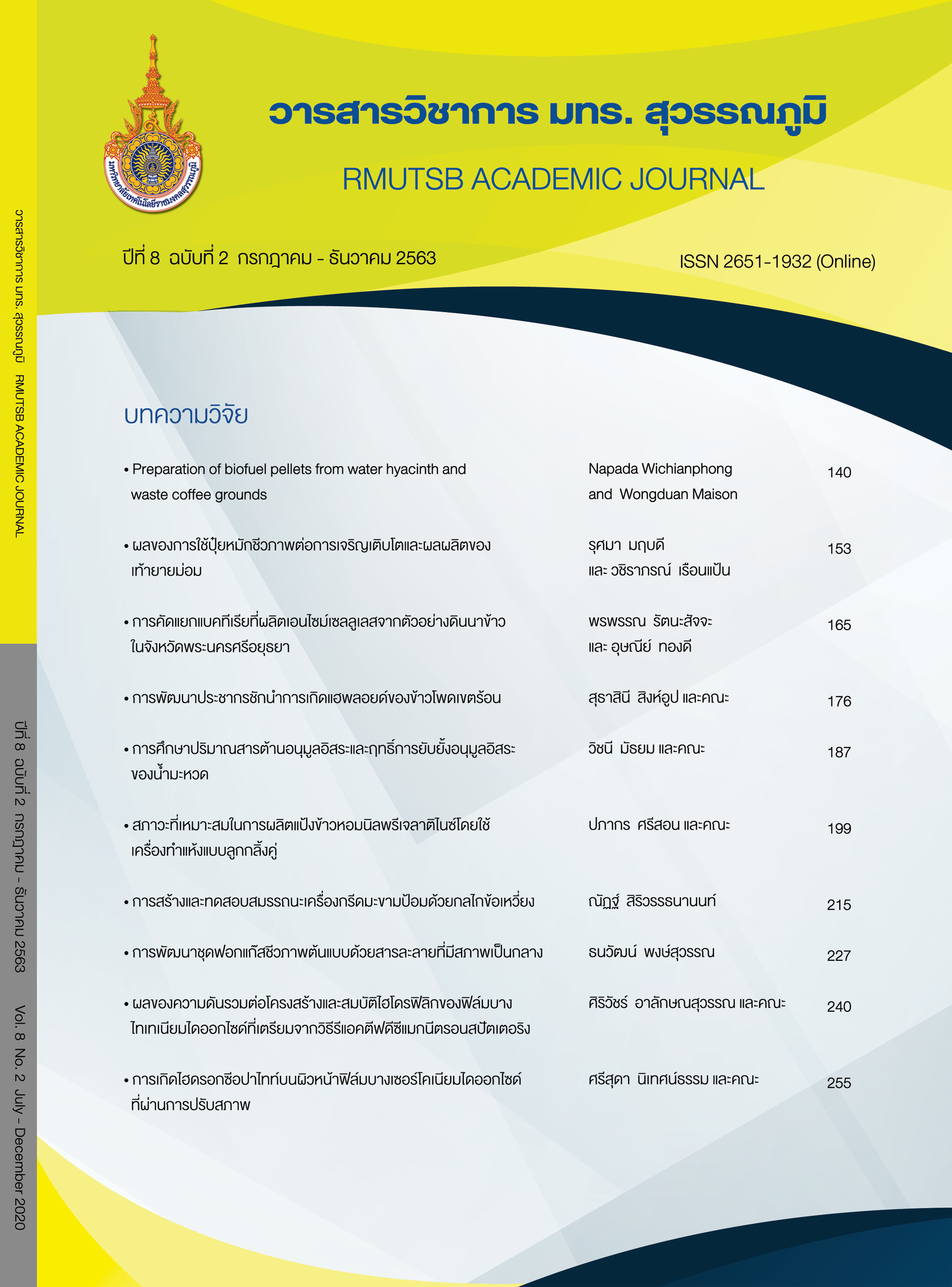Hydroxyapatite formation on surface of treated zirconium dioxide thin films
Main Article Content
Abstract
This research aimed to study the surface treatment of zirconium dioxide (ZrO2) thin film coated on stainless steel by using alkaline treatment, ozone treatment and combined treatment with alkaline and ozone. The alkaline treatment was carried out by soaking ZrO2 thin film in 3 mol/L of calcium chloride (CaCl2) solution at 60 ºC for 24 h. The ozone treatment was performed by introducing ozone gas through the flask containing ZrO2 thin film with flowrate of 250 mg/h for 24 h. The combined method was carried out by introducing ozone gas with flowrate of 250 mg/h through the flask containing ZrO2 thin film soaked in 3 mol/L CaCl2 at 60 ºC for 24 h. Then the hydroxyapatite (HAp) formation on ZrO2 thin film was examined for all treated ZrO2 thin films and untreated sample after soaking in simulated body fluid (SBF) for 7 days. The crystallography of HAp was investigated by X-ray diffraction (XRD). The formation and adhesion of HAp were determined by photographs taken from scanning electron microscope (SEM). Moreover, the element composition of HAp was analyzed by energy dispersive X-ray spectroscopy (EDX). The results showed that the treated ZrO2 thin film provided greater density of HAp formation and higher ratio of Ca/P than that of the untreated sample. Moreover, the sample treated by the combined alkaline and ozone treatments had higher adhesive with HAp and film surface than the untreated sample.
Article Details
Published manuscript are the rights of their original owners and RMUTSB Academic Journal. The manuscript content belongs to the authors' idea, it is not the opinion of the journal's committee and not the responsibility of Rajamangala University of Technology Suvarnabhumi
References
Baszkiewicz, J., Krupa, D., Mizera, J., Sobczak, J. W., & Bilinski, A. (2005). Corrosion resistance of the surface layers formed on titanium by plasma electrolytic oxidation and hydrothermal treatment. Vacuum, 78(2-4), 143-147.
Cao, Y., Weng, J., Chen, J., Feng, J., Yang, Z., & Zhang, X. (1996). Water vapour-treated hydroxyapatite coatings after plasma spraying and their characteristics. Biomaterials, 17(4), 419-424.
Cataoru, M., Bollino, F., Tranquillo, E., Tuffi, R., Dell’Era, A., & Vecchio Ciprioti, S. (2019). Morphological and thermal characterization of zirconia/hydroxyapatite composites prepared via sol-gel for biomedical applications. Ceramics International, 45, 2835-2845.
Hanawa, T. (2004). Metal ion release from metal implants. Materials Science and Engineering: C, 24(6-8), 745-752.
Kizuki, T., Takadama, H., Matsushita, T., Nakamura, T., & Kokubo, T. (2010). Preparation of bioactive Timetal surface enriched with calcium ions by chemical treatment. Acta Biomaterialia, 6(7), 2836-2842.
Kokubo, T. (1998). Apatite formation on surfaces of ceramics, metals, and polymers in body environment. Acta Materialia, 46(7), 2519-2527.
Kokubo, T., & Takadama, H. (2006). How useful is SBF in predicting in vivo bone bioactivity. Biomaterials, 27(15), 2907-2915.
Komlev, V. S., & Barinov, S. M. (2006). Novel bioactive hydroxyapatite-base ceramic and gelatin-impregnated composites. In B. M. Caruta (Ed.), Ceramics and Composite materials: New Research (pp.133-146). New York: Nova science.
Linderbäck, P., Harmankaya, N., Askendal, A., Areva, S., Lausmaa, J., & Tengvall, P. (2010). The effect of heat- or ultra violet ozone-treatment of titanium on complement deposition from human blood plasma. Biomaterials, 31(18), 4795-4801.
Lluch, A. V., Ferrer, G. G., & Pradas, M. M. (2009). Surface modification of P(EMA-co-HEA)/SiO2 nanohybrids for faster hydroxyapatite deposition in simulated body fluid. Colloids and Surfaces B: Biointerfaces, 70(2), 218-225.
Lung, C. Y. K., Kukk, E., Hägerth, T., & Matinlinna, J. P. (2010). Surface modification of silica-coated zirconia by chemical treatments. Applied Surface Science, 257(4), 1228-1235.
Mazaheri, M., Haghighatzadeh, M., Zahedi, A. M., & Sadrnezhaad, S. K. (2009). Effect of a novel sintering process on mechanical properties of hydroxyapatite ceramics. Journal of Alloys and Compounds, 471(1-2), 180-184.
Misaelides, P., Hatzidimitriou, A., Noli, F., Pogrebnjak, A. D., Tyurin, Y. N., & Kosionidis, S. (2004). Preparation, characterization, and corrosion behavior of protective coatings on stainless steel samples deposited by plasma detonation techniques. Surface and Coatings Technology, 180-181, 290-296.
Nagarajan, S., & Rajendran, N. (2009). Sol-gel derived porous zirconium dioxide coated on 316L SS for orthopedic applications. Journal of Sol-Gel Science and Technology, 52, 188-196.
Poolchak, P., Kaewwiset, W., Naemchanthara, P., Hoonnivathana, E., Limsuwan, P., & Naemchanthara, K. (2015). Effect of manganese addition on structure and properties of hydroxyapatite synthesized from eggshells. RMUTSB Academic Journal, 3(2), 182-190.
Song, H.-J., Kim, J.-W., Kook, M.-S., Moon, W.-J., & Park, Y.-J. (2010). Fabrication of hydroxyapatite and TiO2 nanorods on microarc-oxidized titanium surface using hydrothermal treatment. Applied Surface Science, 256(13), 7056-7061.
Sprio, S., Tampieri, A., Celotti, G., & Landi, E. (2009). Development of hydroxyapatite/calcium silicate composites addressed to the design of load-bearing bone scaffolds. Journal of The Mechanical Behavior of Biomedical Materials, 2(2), 147-155.
Sunarso, Toita, R., Tsuru, K., & Ishikawa, K. (2016). Immobilization of calcium and phosphate ions improves the osteoconductivity of titanium implants. Materials Science and Engineering: C, 68, 291-298.
Uchida, M., Kim, H.-M., Miyaji, F., Kokubo, T., & Nakamura, T. (2002). Apatite formation on zirconium metal treated with aqueous NaOH. Biomaterials, 23(1), 313-317.
Wang, J., Chao, Y., Wan, Q., Zhu, Z., & Yu, H. (2009). Fluoridated hydroxyapatite coatings on titanium obtained by electrochemical deposition. Acta Biomaterialia, 5(5), 1798-1807.
Witit-anun, N., & Chaiyakun, S. (2014). Structural and optical properties of ZrO2 thin films deposited by reactive DC unbalanced magnetron sputtering. Advanced Materials Research, 979, 374-377.


